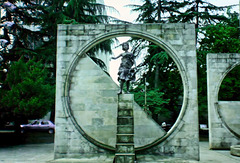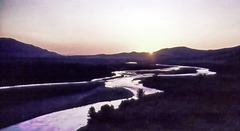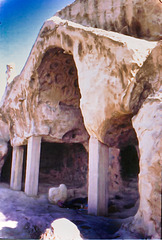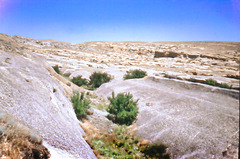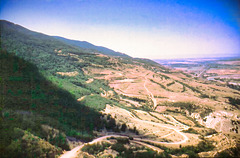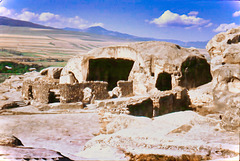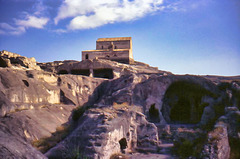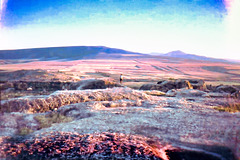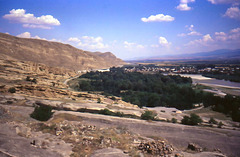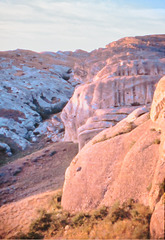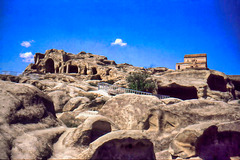m̌ ḫ's photos
Uplistsikhe panorama
| |
|
|
myself 23, somewhere in Georgia
| |
|
|
|
The straw hat I purchased shortly after arriving in Georgia was a traditional folk hat often worn by farmers and those in low-paid jobs. While it may have seemed unusual for a foreigner to wear it, I found it to be incredibly useful in shielding me from the summer heat and direct sunlight. Unfortunately, I left it on the train at the last stop in Uzhgorod. I hope the person who found it had enjoyed it as much as I did.
Unusual Soviet Monument
| |
|
|
|
Located on the side of the street next to Kutaisi City Hall, the Glory to Labour Monument is an interesting example of Soviet art. It was completed around 1980-1 designed by architects Vakhtang Davitaya and Shota Bostanashvili, with sculptures by E. Amashukeli and I. Bastanashvili. The monument is made of bronze and marble. As the name suggests, it is dedicated to the workers of Georgia reflecting the Soviet-era emphasis on the importance of the working class. It is a popular tourist stop for the visitors who are interested in Soviet-era architecture and design.
A river at sunset
| |
|
|
The Mtkvari River flows by Uplistsikhe, Georgia, and plays a significant role in the region's landscape and history. The river is also known as the Kura River and has its source in the mountains of central Georgia, near the town of Lori. The river flows through the eastern third of Kvemo Kartli, a region in central-to-eastern Georgia, and is an important part of the landscape and the site's history in the region of Kartli.
The Theatre
| |
|
|
|
The structure commonly referred to as the 'Theatre' in Uplistsikhe is believed to have been a temple rather than a theatre. It is recognisable for its triangular roof and columns, which are now crude concrete replacements of the original structure. The Theatre is considered too small for a major theatrical performance and is thought to have been used for ritualistic plays, possibly related to religious mystery plays, which were never intended for a large audience. Experts believe that it could date back to the 1st or 2nd century AD and was likely a place of religious significance, adding to the mystical and historical atmosphere of Uplistsikhe.
Countryside seen from Uplistsikhe
| |
|
|
|
Uplistsikhe is situated on a hill within the Gori-Uplistsikhe Ridge. This ridge offers a panoramic view of the surrounding valleys, rivers, and small villages. We can overlook the Mtkvari River Valley, which adds a scenic element to its location. The river winds through the valley, creating a picturesque setting.
The surrounding hills are composed of limestone, creating unique cliff formations. These cliffs add to the dramatic and rugged landscape of the area.Numerous small villages surround Uplistsikhe within the Gori Municipality. Examples include Zemo Khukhuti, Kvemo Khukhuti, Mtskheta, Shalauri, and many others. These villages offer a glimpse into rural Georgian life and often have historic sites, such as churches and fortified towers.
The very top
| |
|
|
|
The area beneath the Prince Church in Uplistsikhe is known as the 'Long Temple' and is another set of cave halls worth a quick glance. The Prince Church is easily recognizable for its brick facade and doesn't quite fit in with its surroundings. The Long Temple is believed to have been a pagan temple, like many other structures in Uplistsikhe. The exact use of the Long Temple is unknown, but it is thought to have been a place of religious significance.
The rock
| |
|
|
Geologically, Uplistsikhe is situated on an impressive rocky plateau carved out of a tuff stone formation. Tuff is a type of volcanic rock formed from consolidated volcanic ash and other pyroclastic materials. The plateau consists of various rock-cut structures interconnected by narrow streets, tunnels, and staircases, forming a labyrinth-like complex. These structures include dwellings, public buildings, a theater, a palace, and even a Christian basilica, indicating the influence of different civilizations that inhabited Uplistsikhe over the centuries.
A church
| |
|
|
You’ve noticed a building that does not quite fit in with its surroundings. The Prince Church is an ancient structure that dates back to the 9th or 10th centuries and is located in Uplistsikhe, an ancient rock-hewn town in eastern Georgia. It is one of the few structures that survived the Mongol invasion, despite the Mongols killing thousands of monks. The reason why the Mongols spared the church is unclear, but it is possible that they used it as their base of operations during the invasion. Uplistsikhe was a pagan holy place before Georgia's conversion to Christianity, and there would have been a prominent temple on the site. It is noteworthy that many churches throughout the Caucasus region were built over the ruins of demolished temples. The decline of Uplistsikhe began in the 12th century after Mongol invasions, although it was still functioning for the next few centuries.
Uplistsikhe
| |
|
A Cult
| |
|
|
|
Uplistsikhe, an ancient rock-hewn town in eastern Georgia was a significant urban settlement, with various structures dating from the Early Iron Age to the Late Middle Ages. The town was a cult temple city and a large pagan centre prior to the introduction of Christianity in Georgia in the 4th century. It was dedicated to the sun goddess and served as a religious center by 1000 BC.
Uplistsikhe
| |
|
Uplistsikhe cave complex has been on the tentative list for inclusion into the UNESCO World Heritage program since 2007
Uplistsikhe
| |
|
Uplistsikhe
| |
|
Uplistsikhe
| |
|
Uplistsikhe
| |
|
|
A troglodyte town in the Caucasus
| |
|
|
|
Uplistsikhe, which translates to "the lord's fortress," is an ancient rock-hewn town located in eastern Georgia, about 10 kilometers east of the town of Gori, Shida Kartli. The town is built on the high rocky left bank of the Mtkvari River and contains various structures dating from the Early Iron Age to the Late Middle Ages. Uplistsikhe is notable for its unique combination of various styles of rock-cut cultures from Anatolia and Iran, as well as the co-existence of pagan and Christian architecture. The town is identified by archaeologists as one of the oldest urban settlements in Georgia. Strategically located in the heartland of the ancient kingdom of Kartli (or Iberia as it was known to the Classical authors), it emerged as a major political and religious center of the country.
With the Christianisation of Kartli early in the 4th century, Uplistsikhe seems to have declined in its importance and lost its position to the new centers of Christian culture – Mtskheta and, later Tbilisi. However, it continued to develop as a town, and the first Christian basilica was constructed in the 6th century. In the 19th century, Uplistsikhe was lost under layers of dirt and sand but was later revived through the efforts of many experts in its excavation, cleaning, strengthening, restoration, and studying. Today, it is listed among the historical monuments protected by UNESCO.
Typical view in Svaneti
| |
|
|
|
Fences have both practical and symbolic significance. They are typically used to protect fields, meadows, and homes from animals and to demarcate property boundaries. These fences are often made from locally available materials. For instance, in the past, Svans used to weave their fences from twigs.



